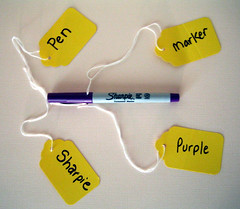#15 - Wikis you'll know and love
Before we get rolling today, I wanted to congratulate you (yes, you) for making it more than half way through our 27 things. Outstanding work, seriously - thanks for participating.
Today, make that this week, we continue onward - we'll be focusing on Wikis.
Simply put, a wiki is website that lets multiple users add, remove and edit content. You don't need to understand HTML (the stuff you see when you view the source of a webpage) and you don't need to know how to use webpage building software. Adding content on a wiki is, with just a few variations, just like using word processing software.
And, even better, you don't need to worry about messing something up - a wiki allows you (or anyone else) to revert to a previously saved version of your webpage. But what if someone changes your entry, one you thought was perfect? A wiki also offers tracking tools that tell you who makes each contribution (the add, the edit, the deletion) and when they made it - you can either revert that page to its previous version or get in touch with the person who made the change.
The collective
Wikis are built by their contributors - readers who add, remove and edit content. And this typically goes one of two ways - an open model where anyone (and I mean anyone) is invited to contribute or a closed model where a select group (say, at KCLS, only LTAs) are invited to contribute. Either way, it is an exercise in trust -whomever contributes is expected to meet certain standards of quality and should expect, should they not reach these standards, that another participant will remove their contributions.
Wikipedia is the best known example of the first model - anyone can participate. Wikipedia does, however, employ staff who will freeze an topic if foul play is reported by readers. Errors and obvious fakeries are often (though, not always) corrected very quickly.
Citizendium is another example of the open model but with increased oversight. The site is including "gentle expert oversight" (staff who check for accuracy) and does not allow for contributor anonymity - contributors must use their real names.
An example of the controlled model? The St. Joseph County Public Library has a limited number of staff members contributing to their version of our Web Links page -'SJCPL Subject Guides.'
More locally? David talks to Sarah Hunt about her Wiki experiences and the two do a bit of futurecasting together in this week's podcast.
Click the Play button above
to hear this week's Podcast (3:35)
More to read
Meredith Farkas has been writing about wikis for years now, and using them for even longer. Take a look at her Wiki’s: A Beginner’s Look. This is an excellent (and short) slide presentation with terrific visuals. You may also want to read her article, Using Wikis to Create Online Communities, on WebJunction.
And, finally, there's Library Success: A Best Practices Wiki. Take a look at their What is a Wiki? presentation. Yes, it's a wiki talking about wikis...
Once you've finished reading up on wikis, it's time to tackle today's Discovery Exercise.
- Take a look at at least 3 of the below:
- that SJCPL Subject Guides wiki
- the full Library Success: A best practices wiki
- ALA MidWinter 2007 Wiki
- Book Lovers Wiki at the Princeton Public Library
- or some of these library wiki examples - Create a blog post about your findings. What did you find interesting? What types of applications within libraries might work well with a wiki?
Up next: become part of the collective...








 You've heard of RSS? You’ve seen these icons (the ones to the right) on your favorite websites? Well, what will they do for you?
You've heard of RSS? You’ve seen these icons (the ones to the right) on your favorite websites? Well, what will they do for you?


